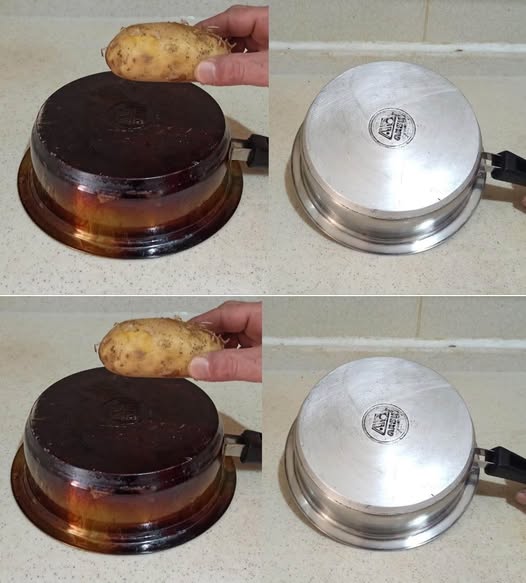ADVERTISEMENT
How to Do It:
- Step 1: Pour 1 cup of vinegar into the burnt pot.
- Step 2: Heat the pot on the stove for a few minutes until the vinegar starts to simmer.
- Step 3: Remove the pot from the heat and sprinkle baking soda over the surface. You’ll see it bubble as it reacts with the vinegar.
- Step 4: Let the mixture sit for 5-10 minutes to cool down.
- Step 5: Scrub the surface with a sponge or brush. The burnt food should come off easily.
- Step 6: Rinse the pot and dry it off.
This combination is particularly effective for stubborn, burnt-on food residue.
3. Salt and Lemon: A Natural Cleaning Duo
If you’re looking for a more natural cleaning method, salt and lemon work great for both cleaning and deodorizing your burnt cookware. The salt acts as a mild abrasive, while the lemon’s acidity helps break down the burnt particles.
How to Do It:
- Step 1: Sprinkle a generous amount of salt on the burnt area of the pot.
- Step 2: Cut a lemon in half and rub the cut side over the salt.
- Step 3: Let it sit for 5-10 minutes to let the salt absorb moisture from the lemon juice and begin breaking down the burnt residue.
- Step 4: Scrub the area with a soft sponge or cloth.
- Step 5: Rinse with warm water and dry the pot.
Not only will your pot look better, but it will also have a fresh, citrus scent!
4. Boil Water and Dish Soap: Simple but Effective
When all else fails, sometimes a good old-fashioned soak can work wonders. Boiling water with dish soap can loosen the burnt particles, making them easier to scrub away.
How to Do It:
- Step 1: Fill the pot with water and add a few squirts of dish soap.
- Step 2: Place the pot on the stove and bring the water to a boil.
- Step 3: Allow the water to simmer for 5-10 minutes, giving the burnt particles time to loosen.
- Step 4: Remove the pot from the heat and allow it to cool down slightly.
- Step 5: Use a sponge or brush to scrub away the burnt residue.
- Step 6: Rinse and dry the pot.
This method is excellent for general cleaning and can help prevent future burns by loosening food residue.
5. Commercial Cleaners: When You Need Extra Power
If you’re dealing with seriously stubborn burns that won’t come off with natural methods, it might be time to turn to a commercial cleaner. Many brands offer products designed specifically for cleaning burnt cookware. Look for cleaners that are safe for your pan material, whether it’s non-stick, stainless steel, or cast iron.
How to Do It:
- Step 1: Follow the instructions on the cleaner’s label.
- Step 2: Apply the cleaner to the burnt areas of the pot.
- Step 3: Let it sit for the recommended amount of time, then scrub with a non-abrasive sponge.
- Step 4: Rinse thoroughly and dry.
6. Prevent Future Burns: Best Practices for Cooking
To avoid burnt pots in the future, here are some tips to keep in mind:
- Use lower heat settings: High heat can quickly cause burning. Cooking on medium or low heat is better for preserving your pots and food.
- Keep an eye on your cooking: Try not to leave pots unattended on the stove for extended periods.
- Stir regularly: This helps distribute heat evenly and prevents food from sticking or burning.
- Choose the right cookware: Ensure that your pot is suitable for the type of food you’re cooking. Some materials, like non-stick, are more prone to burns if not used correctly.
Final Thoughts: Bringing Your Burnt Pot Back to Life
Before you give up on your burnt pot, remember that there are plenty of methods to restore it to its former glory. Whether you use natural ingredients like baking soda and vinegar or a more intense commercial cleaner, you can easily tackle the burnt residue and have your cookware looking brand new. With the right care and cleaning techniques, your pots and pans can serve you for years to come—without the need for an expensive replacement.
ADVERTISEMENT
